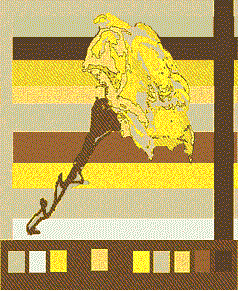


This is the third workshop I have attended ( and the second time I have written about it: see Jacquard Journey in Fibre Quarterly 2005 Anthology or Surfacing Journal Summer 2002, Volume 24, Issue 2) and each time a philosophical question comes up about “Why weave a photograph?” The simple answer is you can clime Mount Everest because it is there. It is however a more interesting question than that. As the development of the Jacquard loom made a dramatic change in Western Weaving Traditions of Europe that were progressing through the racial changes of the on going “Industrial Revolution”, the invention of the Camera brought about a ground swell of innovation and radical change to the very essence of painting. The camera allowed/ forced painters and “art critics” and philosophers to see with new eyes. During the same time period of the mid 19th century science developed new pigments for paint and dyes that gave a new pallet to use, some dyes more destructive to the yarns being used at the time ( history tells use many things) then others. That is a different story.
With the Centre for Contemporary Textiles and these workshops under the instruction of generous and patience Louise Bérubé, give the opportunity for both practicing weavers and non weaving artist the time to experiment with this concept. Computers give us a variety of method by which to acquire or create and alter images/ patterns. The Jacquard loom also provides another set of choices and chances to sequentially alter images, weaving being a method of building surface a thread at time, weave structure and yarn composition and colour adding yet more elements to these chances to achieve effects within the constraints of the medium. The finished Jacquard cloth in itself becomes yet another medium to embellish, alter and manipulate makes the original question of “why weave a Photograph?” almost a mute point. Max Allen of the Textile Museum of Canada likes to say that textiles are a site of story telling let me get on with telling you about my two weeks at the Montreal Centre for Contemporary Textiles.
Shaded Satins plain and simple: The source material guy above and guy over to the right, The design below, The simulation and yes this one was actually woven. And why weave a photograph? Why not?
This shaded Satin has been woven and is entitled “two guys and a cigarette” is 40” wide by 18” approximately.
Next: Double weave: 2 warps (white) 2 wefts (2. different colours/ layers) stitched
End of Week one,
As weavers techinal langauge and graphic depictions of weave stuructures are recognizable and for non weaver it must be obvious that the grid is ultimately the basic source of all weaving design. This is information that is as complicated or simple as your personality allows it to be and it is the backbone of what these workshops are about: processing designs down to the technical instructions for the computer operated Jacquard loom to follow. You need to “Suspend your disbelief” in the Bretchtian sense when you approach most new software, you must believe it works, not necessarily understand how it works that will come with time
Too Weak need more coffee Week Two
Since I have already over loaded you with text week two will just be images. I have put this in the Aroundtown Blog for expedience sake to show my fellow workshop participants what I was working on and now invite the rest of them to submit their own images and thoughts. I have also put this in the Blog to let other artist and Textile people get an inside view of the work it is possible to contemplate doing through the MCCT under the tutelage of the gifted Louise Bérubé


Multi Coloured Satins
1 Warp (white) 3 Wefts A( brown) B ( light Brown) C (yellow)


Multi Coloured Shaded Satins , 2 Warps (white) 2 Wefts A (brown) B (orange)

 Shaded Satins with Shaded Brocade
Shaded Satins with Shaded Brocade1 Warp (white) 2 Wefts A(orange), B (brown brocade)


Now the mistake would be to have not have had a naming strategy for keeping ones files in proper order. In the Pointcarré software as I have said there are several different windows in which you can work on your design and weave structures and the finally saving a the cloth window along with its harness tie up into a different software readable by the Looms computer and at any step along the way you can misplace or lose any one of them, because ultimately we are only human and when trying to provide the all mighty computer with all it requires we are capable of trashing the harness tie ups, placing the cloth page in the wrong file and ….
One of the workshop weavers Marilyn Bernier is a graduate of the Centre and has her own Studio Shop in Montreal the website is www.bure-linon.com
You can visit the Centre's website at
http://www.textiles-mtl.com/English/e_Main.html
and Louise Lemieux Bérubé may be found on line at http://web.mac.com/llemieuxberube/SiteE/Welcome.html
The schedule for the 2007 jacquard workshops can be found on the Workshop and Conference page of fibreQUARTERLY

No comments:
Post a Comment